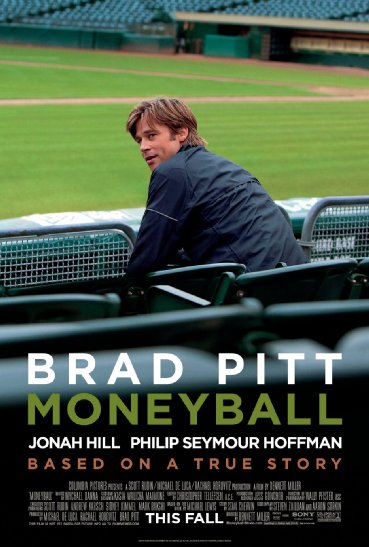If you are not a fan of statistics watch the clip below.
If you are a fan of statistics watch the clip above.
Now that you have watched the above clip let me explain to you a little bit about what you just saw. You just saw a trailer of the film “Moneyball” (2011). It starred Brad Pitt and Jonah Hill and the movie was based off of a book by Michael Lewis titled, “Moneyball: The Art of Winning an Unfair Game” (2003). Pitt plays Oakland A’s general manager Billy Beane and Jonah Hill plays Peter Brand a fictitious character who was based off of Paul DePodesta. Plain and simple, the movie is about how Beane was trying to assemble a baseball team by using statistics with the assistance of Peter Brand. Throughout the movie Beane has his back against the wall as he attempts to convince the other members of the Oakland A’s management that he is not doing a gimmick. In fact, he relies on statistics to not only assemble the team but to dictate the positions they will play once they are in the baseball field.
Beane is the “David” of this story and the naysayers are the “Goliath”. Beane is applying statistics to an unfair game because the Oakland A’s did not have the finances to retrieve baseball players who want to get paid a considerable amount of money. Traditional subjective evaluation of potential vs. objective sabermetrics is what Beane was up against. To put it differently, the old way of thinking verses the new way of thinking is what the movie was about.
Statistics may be boring to many people, but once an understanding is made between the linkage of statistics and how this can improve a game that has been cemented in American culture, statistics turns into something that is more than just numbers. It has to do with changing the story of baseball. Statistics has changed the story of MLB and the game will never be the same again. In fact after Beane adopted the new methodology it has been embraced by many other baseball teams including the Boston Red Sox.
I highly recommend watching the movie “Moneyball” or reading the book “Moneyball: The Art of Winning an Unfair Game” by Michael Lewis. I am currently reading the book and it talks more about statistics and the reader gains another level of appreciation for the subject as well a the game of baseball. Yes, “Moneyball” (2011) is about baseball. But rest assured the story of “Moneyball” has more to do with than just America’s favorite past time. It has to do with using statistics to challenge the conventional way of thinking that many in the Major League Baseball (MLB) industry have relied on for an insurmountable amount of years.
Whether you think statistics is a boring subject that never learned to catch your interest, you need to lighten up. Try to understand that statistics is used by many people throughout the world for various fields including Wall Street all the way down to professional baseball teams. Maybe statistics confuses many people by the intimidation they feel by the complex world of numbers, equations, and graphs. Put all of this to the side, and we will see that statistics helps us tell stories of David and Goliath.



I’m not the biggest sports fan, but this is the second time seeing this clip. It is a great clip to illustrate how math (or reason for this matter) can “change the story” as you so well put it. The first time I saw the clip was in the context of an integrative epistemology course where numbers/stats/reason is used as ‘a way of knowing.’ A good intersection good man.
LikeLike
Thank you foolsblood.
LikeLike
Math/statistics and I have never gotten along nor am I the biggest fan of sports. But your post definitely shows that there is reason to it and does have the power to change the course of a story. I may never fully grasp statistics but thank goodness there are people that do and can change a course.
LikeLike
Although I’m a fan of Brad Pitt, I haven’t seen this movie yet because I’m not a fan of baseball game and statistic. But your post really caught my interest that I want know about how the screenwriter connect the statistic and sport game to create a story. I used to know statistic can help us to tell a better story. And now I know statistic can be a story itself.
LikeLike
Moneyball is a really great movie. Even more so, I think it sort of set the stage for the new use of sabermetrics (http://en.wikipedia.org/wiki/Sabermetrics) within baseball. For those not familiar with the term, it’s basically advanced statistic metrics that many of the more forward-thinking Major League Baseball teams are using to rate their players as well as other players to see who would be the best fit for their team. Very interesting stuff.
LikeLike
Statistics and big data are taking a huge place in sports. Check out this article on how data helped germany win the world cup! http://blogs.wsj.com/cio/2014/07/10/germanys-12th-man-at-the-world-cup-big-data/
LikeLike
With the rise of ‘Big Data’ and folks like Nate Silver, Money ball seems almost prescient in the way it predicted how sports would operate with the aid of data and numbers. Unfortunately the Oakland A’s are pretty much an anomaly nowadays, since everyone pretty much uses the same stats.
LikeLike